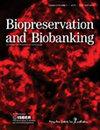Effect of Pectins on Water Crystallization Pattern and Integrity of Cells During Freezing.
IF 1.4
4区 生物学
Q4 CELL BIOLOGY
Biopreservation and Biobanking
Pub Date : 2019-01-01
Epub Date: 2018-10-09
DOI:10.1089/bio.2018.0066
引用次数: 7
Abstract
The ability of various pectin polysaccharides to modify the morphological structure of ice during the phase transitions from water to ice was studied. Pectins were isolated from Sosnowsky's hogweed Heracleum sosnowskyi Manden (heracleuman-N6HS), tansy Tanacetum vulgare L. (tanacetan-N7TVF), and Rauwolfia serpentina Benth callus (rauwolfian-N8RS). Pectins were isolated by multistep extraction. The effect of pectins was assessed using osmometry, thermographic analysis, and cryomicroscopy. A concentrate of leukocytes was used as the sample for the subsequent freezing step. The condition of the leukocyte membrane, and lysosomal and phagocytic activity after a freezing-warming process were assessed. Osmotic concentrations of the pectin polysaccharide solutions were found to be very low. The 0.4 wt % N7TVF solution had the highest osmotic concentration as well as freezing point; however, the duration of its crystallization plateau was lower than that of the 0.4 wt % and 0.2 wt % N6HS solutions. All studied polysaccharide solutions demonstrated a high linear rate of ice crystal growth. There were statistically significant differences between the melting rates for the 0.2% solutions of the pectins, N6HS and N7TVF, N6HS and N8RS, as well as between concentrations for the pectin N7TVF and between concentrations for the pectin N8RS. The data on the integrity of cells that are frozen in a medium containing polysaccharides may indicate a cryoprotective effect of the N7TVF and N8RS pectins, that is, tanacetan from tansy and rauwolfian from rauwolfia. The most effective modifier among the substances, which were studied by us, was the N7TVF pectin polysaccharide (tanacetan from tansy).果胶对冷冻过程中水结晶模式和细胞完整性的影响。
研究了不同果胶多糖对冰从水到冰相变过程中形态结构的影响。从大猪草Heracleum sosnowskyi Manden (heracleman - n6hs)、Tanacetum vulgare L. (tanacetan-N7TVF)和Rauwolfia serpentina Benth愈伤组织(rauwolfian-N8RS)中分离得到果胶。通过多步萃取分离出果胶。果胶的效果是通过渗透法、热成像分析和低温显微镜来评估的。白细胞浓缩液用作随后冷冻步骤的样品。观察冻暖处理后的白细胞膜状况、溶酶体和吞噬活性。发现果胶多糖溶液的渗透浓度很低。0.4 wt %的N7TVF溶液具有最高的渗透浓度和凝固点;然而,其结晶平台的持续时间比0.4 wt %和0.2 wt %的N6HS溶液短。所有研究的多糖溶液都显示出冰晶生长的高线性速率。0.2%果胶、N6HS与N7TVF、N6HS与N8RS、N7TVF浓度与N8RS浓度之间的熔融速率差异有统计学意义。在含有多糖的培养基中冷冻的细胞完整性数据可能表明N7TVF和N8RS果胶(即来自tansy的tanacetan和来自rauwolfia的rauwolfian)具有冷冻保护作用。在我们所研究的物质中,最有效的改性剂是N7TVF果胶多糖(tanacetan from tanansy)。
本文章由计算机程序翻译,如有差异,请以英文原文为准。
求助全文
约1分钟内获得全文
求助全文
来源期刊

Biopreservation and Biobanking
CELL BIOLOGY-MEDICAL LABORATORY TECHNOLOGY
CiteScore
3.30
自引率
12.50%
发文量
114
审稿时长
6-12 weeks
期刊介绍:
Biopreservation and Biobanking is the first journal to provide a unifying forum for the peer-reviewed communication of recent advances in the emerging and evolving field of biospecimen procurement, processing, preservation and banking, distribution, and use. The Journal publishes a range of original articles focusing on current challenges and problems in biopreservation, and advances in methods to address these issues related to the processing of macromolecules, cells, and tissues for research.
In a new section dedicated to Emerging Markets and Technologies, the Journal highlights the emergence of new markets and technologies that are either adopting or disrupting the biobank framework as they imprint on society. The solutions presented here are anticipated to help drive innovation within the biobank community.
Biopreservation and Biobanking also explores the ethical, legal, and societal considerations surrounding biobanking and biorepository operation. Ideas and practical solutions relevant to improved quality, efficiency, and sustainability of repositories, and relating to their management, operation and oversight are discussed as well.
 求助内容:
求助内容: 应助结果提醒方式:
应助结果提醒方式:


